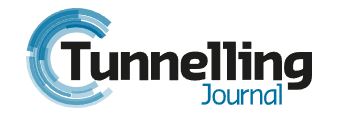Tunnelling Journal November coverage
hyperTunnel is referenced in two articles in the October / November issue of Tunnelling Journal, following our exceedingly well-received launch at the British Tunnelling Society’s (BTS) Conference & Exhibition in London in September. Here are the excerpts:
Editor’s comment (page 5)
…we saw an interesting presentation from hyperTunnel. It looks a very promising concept, and certainly worthy of investigation, but to me one of the most intriguing aspects is the use of an innovative form of horizontal directional drilling to pre-investigate the geology along a tunnel alignment, following the actual tunnel route. NOT via ludicrously spaced vertical boreholes that only provide snapshots of the alignment’s ground conditions. Imagine knowing exactly where conditions will change so far in advance that you could plan your entire excavation methodology around such a GBR. So, good luck indeed to the fledgling hyperTunnel company. I’m 100% sure we’ll be seeing much more of them in the future. But if only one thing came from the new venture, a new reliable method of ground investigation, it would indeed be a real game-changer and allow GBRs to be used in the way they are truly intended.
New Horizons at BTS (page 11)
The most heavily-attended session of the conference was a presentation on hyperTunnel, by its chair, Mark Carne. Curiosity drove many exhibitors to desert their stands in a bid to find out more about this company that claims to be totally reinventing tunnelling. In brief, the hyperTunnel process involves using HDD around the perimeter of a tunnel and treating the ground from those drill bores before cutting out the cross section (read more about hyperTunnel in the September 2021 issue of TJ).
While hyperTunnel’s engineering team is drawn from diverse backgrounds such as Formula 1, aviation and mechatronics, Carne himself had a long career in the oil and gas sector, before heading up Network Rail, and drew a clever analogy based on that. He recounted how an oil discovery off the coast of Brazil, where no-one had ever looked before, was like hyperTunnel’s approach to tunnelling; whereas Elon Musk’s goal of improving tunnelling using a TBM was like carrying out exploration in areas known to contain oil.
hyperTunnel’s approach relies on technology that others in the industry might consider cutting edge – robots, swarm technology, AI – but which hyperTunnel engineers consider everyday. However, perhaps the biggest challenges could be chemical rather than digital: developing the chemicals needed to treat the ground without causing environmental concern or pushing the cost too high for viability.
To read the magazine issue in full, click the link below.
| October/November issue (digital) of Tunnelling Journal

